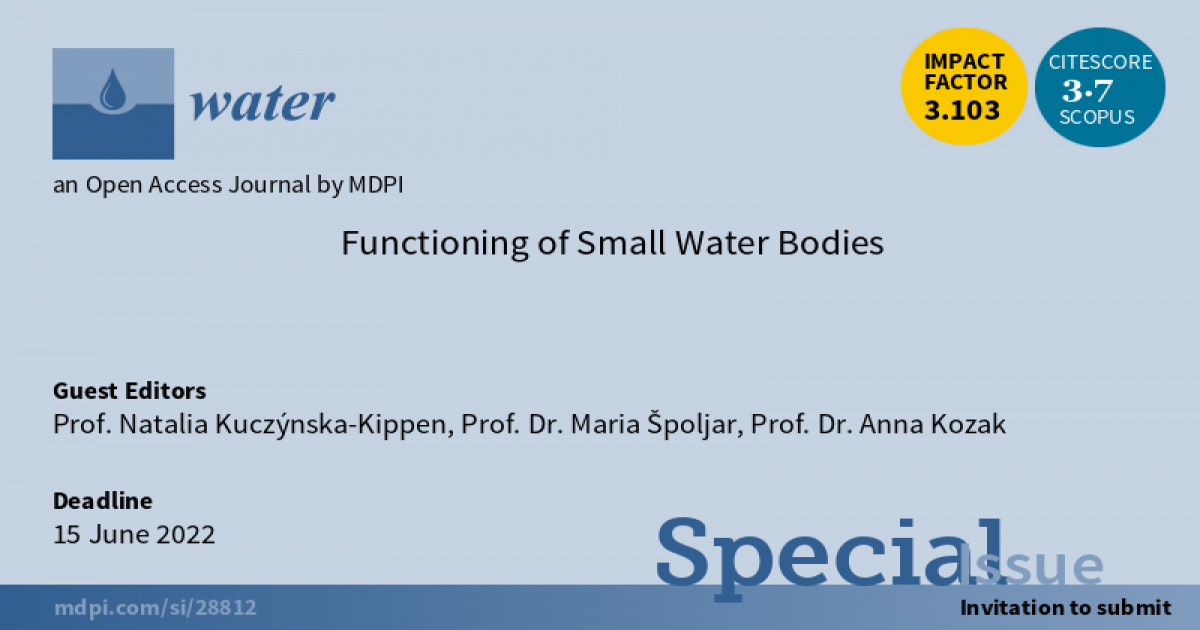Functioning of Small Water Bodies
A special issue of Water (ISSN 2073-4441). This special issue belongs to the section "Biodiversity and Functionality of Aquatic Ecosystems".
Deadline for manuscript submissions: closed (15 June 2022) | Viewed by 12330

Special Issue Editors
Interests: Aquatic sciences; Zooplankton Ecology; Biodiversity & Conservation; Ecology and Evolution; Predator - Prey Interactions
Special Issues, Collections and Topics in MDPI journals
Interests: freshwater ecology; zooplankon and microfaunal ecology; food web interactions; water quality; restoration and conservation
Special Issues, Collections and Topics in MDPI journals
Interests: aquatic ecosystems; cyanobacterial blooms; biomonitoring; environmental science; phytoplankton; phytozooplankton relationships; lake restoration; water quality
Special Issues, Collections and Topics in MDPI journals
Special Issue Information
Dear Colleagues,
Small water bodies play a very important ecoton role, being a transitional system between various biocoenoses and aquatic ecosystems and also creating an interface between terrestrial and aquatic environments. Thus, they build a bridge that connects various wetlands, favouring the migration of many species. Generally, their large abundance worldwide and extensive total area, greater than that covered by lakes, contribute to maintaining high biodiversity. In spite of the fact that ponds located in a landscape with a low degree of transformation harbour decisively higher biodiversity than ponds in areas with a large impact of anthropepression, both types of water body can contribute to the enrichment of flora and fauna on local and regional scales. The high ecological value of these aquatic environments is expressed in the occurrence of specific pond species as well as in a generally high share of rare species that find favourable and often undisturbed life conditions in ponds. The hydrological functions of ponds are very variable throughout the year and highly depend on the level of water storage in the catchment of a water body. Because the number of ponds is generally decreasing, it is essential to develop effective arguments that will lead to the protection and maintainance of these valuable ecosystems.
Prof. Natalia Kuczýnska-Kippen
Prof. Dr. Maria Špoljar
Prof. Dr. Anna Kozak
Guest Editors
Manuscript Submission Information
Manuscripts should be submitted online at www.mdpi.com by registering and logging in to this website. Once you are registered, click here to go to the submission form. Manuscripts can be submitted until the deadline. All submissions that pass pre-check are peer-reviewed. Accepted papers will be published continuously in the journal (as soon as accepted) and will be listed together on the special issue website. Research articles, review articles as well as short communications are invited. For planned papers, a title and short abstract (about 100 words) can be sent to the Editorial Office for announcement on this website.
Submitted manuscripts should not have been published previously, nor be under consideration for publication elsewhere (except conference proceedings papers). All manuscripts are thoroughly refereed through a single-blind peer-review process. A guide for authors and other relevant information for submission of manuscripts is available on the Instructions for Authors page. Water is an international peer-reviewed open access semimonthly journal published by MDPI.
Please visit the Instructions for Authors page before submitting a manuscript. The Article Processing Charge (APC) for publication in this open access journal is 2600 CHF (Swiss Francs). Submitted papers should be well formatted and use good English. Authors may use MDPI's English editing service prior to publication or during author revisions.
Keywords
- Aquatic diversity
- Ponds and shallow lakes
- Human impact
- Biocontamination
- Relationships between abiotic parameters and biocoenoses
- Environmental assessment
Benefits of Publishing in a Special Issue
- Ease of navigation: Grouping papers by topic helps scholars navigate broad scope journals more efficiently.
- Greater discoverability: Special Issues support the reach and impact of scientific research. Articles in Special Issues are more discoverable and cited more frequently.
- Expansion of research network: Special Issues facilitate connections among authors, fostering scientific collaborations.
- External promotion: Articles in Special Issues are often promoted through the journal's social media, increasing their visibility.
- e-Book format: Special Issues with more than 10 articles can be published as dedicated e-books, ensuring wide and rapid dissemination.
Further information on MDPI's Special Issue policies can be found here.







